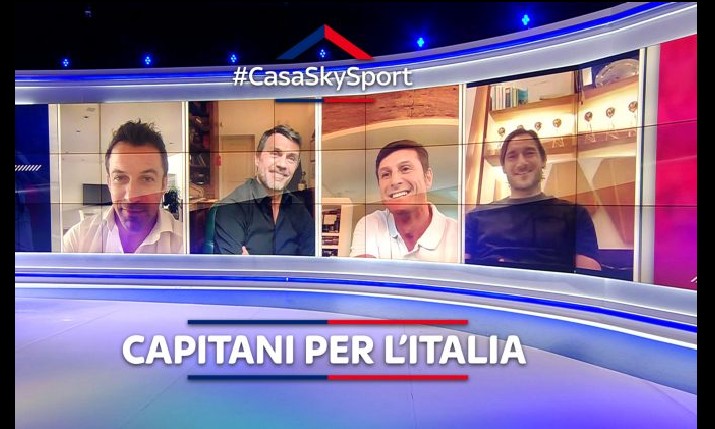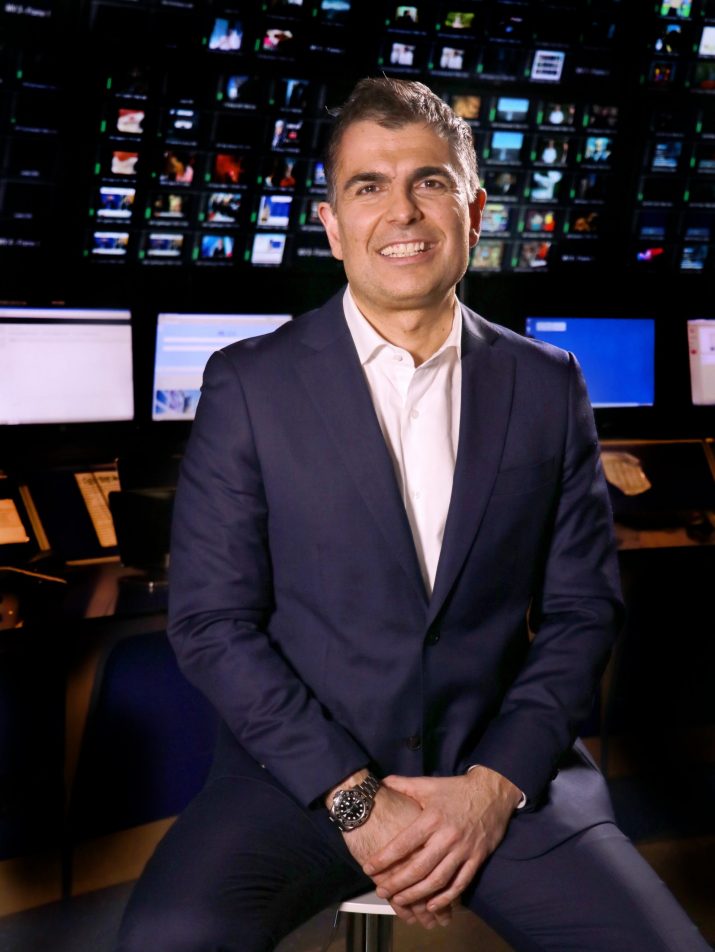How Sky Italia has adapted its content and operations through the coronavirus lockdown

Italian legends Del Piero, Maldini, Zanetti, Totti on Casa Sky Sport, Sunday 12 April
Sky Italia senior director of Production Broadcast and Creative Hub Riccardo Botta has told SVG Europe how the broadcaster moved to remote working well before the lockdown in Italy and has now mixed various professional, prosumer and consumer technologies together to enable work to continue and shows to remain on air during the crisis.
“Protecting our people has been, at all times during this emergency, our number one priority,” said Botta. “While doing that, we have been working to continue to provide our customers with the best content experience.
“Sky has put almost all of its employees in smart working since 24 February, two weeks ahead of the government-imposed lockdown on 8 March. From that day, the area of Content Tech and Operations that I manage has 90% of its people working from home.”
What impact has the coronavirus emergency had on production and the supply chain of content at Sky Italia?
“The impact varies depending on the content. So far, there has been no significant impact on recorded content since the series and movies had been finalised pre-COVID.
“Live shows are the most impacted by the current situation. At Sky we did not have many of these type of shows planned for these months, although our Late Night Show (EPCC), which returned on air this month, goes live from a theatre without an audience.”
Were programmes cancelled?
“With the exception of live sport, we did not lose any significant content. On the contrary, Sky TG24 was strengthened with dedicated coronavirus content and programmes.
“We used technologies to enable our news department to be even more effective in working remotely and from different areas of the country, in order to be able to report thoroughly and timely all relevant news on this terrible disease. For instance, thanks to the use of technology, we have launched anchoring from home for SkyTG24 and, as of last week, two or three editions a day are fully anchored from home.”
How did you adjust your programming schedule to make up for lost content (live sports)?
“Clearly, the suspension of virtually all live sports has affected our sports schedule significantly. However, Sky Sport has immediately put together a new schedule, which includes a lot of interaction with our customers, allowing them to be much closer to sportsmen and commentators (Casa Sky Sport (pictured, above), Juke Box) and we used content from our library to create themed-days (e.g. dedicated to the national team’s greatest games).
“Despite the emergency, some key shows like Calciomercato and Sky Calcio Club have returned on air on Sky Sport24 thanks to new formats specifically tailored in compliance with social distancing rules. The anchors are the only ones physically in studio and the immersive technology — Ledwall and Robycam – allows for a 360° view. All the guests are connected through LiveU, Skype and Facetime.
“We also started broadcasting eSports (Football, F1 and MotoGP) in an ‘interactive’ way and have given journalists the ability to perform live or non-live voiceover of events from home or hybrid (main voice on-prem, second voice at home). Finally we have experimented with some small new content produced directly from home from our sport talents (like CasaVanz).”
What technologies did you put in place to guarantee production and distribution of content?
“This emergency has accelerated some processes that were already in progress. We deployed a hybrid model: everyone in post and GFX works from home.
 “For studio ops, we adopted a hybrid approach with some roles on site and some roles at home: we have put in place a heavy use of cellular bonding newsgathering (mainly based on LiveU kits) and full integration of Skype, FaceTime and TEAMs in the production environment. Parts of the gallery (EVS operations, editorial coordination) are operated remotely and we deployed a cloud-based gallery (as SaaS or Iaas) with Viz Verdi and NewTek. In post production we have started to use PCoIP Solutions to enable editors to work 100% from home using the same workflows that they would use on prem. We also use standalone post production SW, for editing, sound design and grading of high-end programmes like special features, art movies or documentaries and started to use full cloud based solutions in SaaS mode.
“For studio ops, we adopted a hybrid approach with some roles on site and some roles at home: we have put in place a heavy use of cellular bonding newsgathering (mainly based on LiveU kits) and full integration of Skype, FaceTime and TEAMs in the production environment. Parts of the gallery (EVS operations, editorial coordination) are operated remotely and we deployed a cloud-based gallery (as SaaS or Iaas) with Viz Verdi and NewTek. In post production we have started to use PCoIP Solutions to enable editors to work 100% from home using the same workflows that they would use on prem. We also use standalone post production SW, for editing, sound design and grading of high-end programmes like special features, art movies or documentaries and started to use full cloud based solutions in SaaS mode.
“We strengthened mobile editing and created new workflows to be able to remotely operate critical operations like dubbing and EVS contribution. For MCR and International Commentary Area we activated remote control of most of the equipment, a hybrid model for operators and activated ‘meshed MCR’ with Sky Group and external partners.
“For the playout we implemented a hybrid model with more than 70% of the workload managed from home. Operators can access their working station and receive the channels preview of multiviewer on low latency encoders streaming on srt.”
“In general, we are working in a fully distributed mode and technology is helping a lot. We are leveraging on all the tools of the Office 365 suite and we use them to deploy a fully ‘digital native’ way of working.
“For instance, in these days of emergency a journalist, an editor and a GFX designer can work simultaneously on the same news piece, each one from their own home but collaborating real-time. Thanks to these technologies, recently we also had our very first virtual press conference for Diavoli, using our studio to connect 60 journalists and the six key actors and directors.”
Was it difficult to implement these innovations in such a short timeframe?
“Most of the technology and the internal skills needed were there. We did not create anything from scratch. What made the difference was being able to mix the available capabilities.
“Content and broadcast technology is moving away from monolithic and one-size-fits-all operating and tech models. Today, it’s possible to mix and match tools and operating models according to each need.
Some of the use cases we created for this emergency are a mix of consumer, prosumer and professional equipment, SaaS, IaaS, on prem, studio, and work from home. These are integrated in single seamless workflows. Some of the technologies we are using are cheap and cost just a few euros whilst others cost hundreds of euros, and both are mixed in the same workflow.
“Imagine a world of LEGO blocks where you can build the service according to your needs. Everything, in technology and operations, can be fitted to the purpose.”
How are you planning for phase 2?
“Content operations and technologies essentially have never stopped. We switched gear a bit (on some areas like Sport), changed the work allocation and location and introduced new formats, such as anchoring from home in our news service SkyTG24. We also introduced strict rules in our Media Hubs.”
